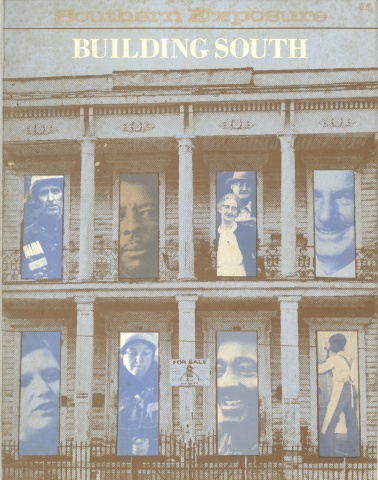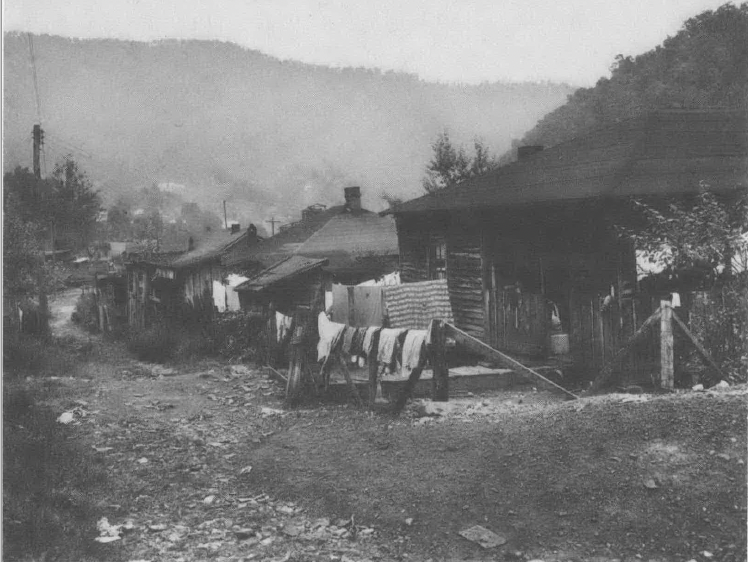
This article originally appeared in Southern Exposure Vol. 8 No. 1, "Building South." Find more from that issue here.
From Winona, once a town
at the head of Keeney’s Creek,
past the stone columned building, once a bank,
and past the houses of the camp long since
abandoned,
a track bed stripped of tie and rail
switchbacks down the wall of the Gorge.
A branch line pulled by corporate decision
and the sheer weight of taxes
left this one lane trail of rock and sand
where we descend, four in a jeep, laughing
through tunnels of the colors of autumn
to the main line of the C & 0
along a hundred million years of river run.
Our guide leaves off his old jokes and reads
this history from a book:
The completion of the lines was
celebrated on January 2, 1873,
at Hawk’s Nest. In that same
year Joseph Lawton Beury’s small
mine at Quinnimont shipped the
first coal from the New River Field.
The book passed around, and the dusty photographs
let us in briefly
to see the air heavy with soot and the timber
clear cut to the naked cliff walls.
And we see how
in the history of industry Beury’s memory
is fixed in stone
at Quinnimont overlooking the rapids.
Here in the river camps nothing remains
except these houses in the shadow of the cliffs
and pilings of a footbridge
that crossed the river to the Red Ash Mine.
“What’s that up ahead?”
“Looks like someone walking the tracks.”
We follow our guide
as the noon sun beats the distant rails
to rubbery incandescence. We come upon
the beehive coking ovens’ crumbling brick.
“People lived in them
in the thirties, whole families. Saw one even
had a piano in it.”
Off in the distance
an old woman watches us, then moves on slowly,
a large bundle on her back.
“Who is she?”
“What’s she doing there?”
“It’s Melsina. She’s just goin down to Thurmond.
Carries all her belongings on her back. She
worked in the old Beury mansion. Stayed on there
by herself when they closed it up. Train crews
look out for her. Sometimes you see her carrying
an old stray dog like a baby.”
We watch her movement fade into haze
toward Thurmond,
Believe It or Not City, three times in Ripley,
the town with a railroad for main street.
“Not much there now.”
We turn back, walking north, listening
to its tales.
“. . . had the finest hotels, and I can remember
the bar, the whiskey stacked behind the bar,
and the big one dollar slot machines giving
them silver dollars,
and the gambling tables lined with velvet . . .”
We pass under the old Nuttalburg coal conveyor —
“I seen five thousand dollars change hands
in a game of poker . . .”
coming off the cliffs five hundred feet up.
“. . . professionals coming in from the cities is
what finally broke it up.”
Still owned by Henry Ford.
“First steel tipple on New River,” our guide says.
Now rusting away, wooden steps already gone,
no way up to the controls.
“Shut down after the War and left it all.”
The miners recycled the rest of the camp, took
the architecture elsewhere for re-use.
“Look at this!”
(at the stone foundations of the camp church)
“The operators would always build a church,
to have a place to give the dead miners
a funeral in.”
“Yes, and what about the preachers? There never
was a shortage of preachers.”
“You’ve heard about the Yellow Dog, Pete?”
We head back for the jeep, at Caperton camp.
“I seen it put into effect, there
across the river —
old man Collins brought in Baldwin-Felts men;
they put a machine gun
and a searchlight
on the tipple overlooking the camp.”
At Caperton
we rest on steps of a big double house,
admiring the carpenter’s work, everything
done by hand,
neatly trimmed, a little something extra for
the section bosses.
Here the tipple is gone, no sign of the mine.
One question leads to another, and one exclaims,
“Low coal! Lord,
I loaded coal in nineteen inches, where you had
to lay on your side,
and if you had a little lump like that, you had
to beat it up before you could get it
into your car.”
And what follows is talk of pickwork and scabwork
and fixing track and being blackballed with
the Union in ’21.
How you had to be strong as a bristleback,
and our guide says, yes, he worked with a fellow
that had one arm off, had just a short stub,
called him “Wing,”
one of the best coal loaders there was.
And play the piano, why after meetings they
would ask him
and Wing would take that stub and hit the bass
notes and rock back and forth and make the best
bass run you ever heard.
And he had a by-word, he used to say, “John Brown.”
He’d say, “John Brown, I love workin’.”
And the yarns spin
until the dead and scattered faces that lived
here once call in a rush of memory that
leaves us restless,
and standing we see houses, no more than
rotting shells on the hill behind us,
the warm sun softening their sunken roofs.
“An old man lived
here for a while on Social Security checks.”
We walk past a shack on a carpet of lilies
growing in the yard.
Brick chimney torn down, rusting washbuckets
strewn about, and what must have been his
bed frame and springs outside the door, as
though he’s slept out under the stars.
Then in the jeep,
grinding the trail back across the tressels
of steel over waterfalls,
past thick stone walls, laid by hand,
following the switchbacks,
old railroad warning ropes still hanging,
to the miserable remains of life at the rim,
the hollow there
a rut filled with cans, bottles and old tires,
the unpainted houses a story of discipline and
a generation’s pain,
of an extraction that gave next to nothing
in return — here a serenity of decay in wilderness
which comes back lush
and strangles what remains like a tourniquet
on a wound.
We drive home in silence, remembering the labor
of the dead, coal fires that burned at night,
and this rubble left behind.
On September 8, 1901 a railroad construction crew blasted the sandstone cliffs on the south side of New River, opposite Thurmond. When the smoke cleared, there was a perfect profile of President McKinley formed on the cliff. The startled laborers, mostly Italian, fell to their knees, crossed themselves, and cried, "Holy Mother!" That afternoon word was received that the President had been shot in Buffalo, New York.
Tags
P.J. Laska
P.J. Laska was raised and still lives in the West Virginia coal fields. His third collection of poems, Wages and Dreams, will be published in the spring of 1980 by Mountaineer Freedom Press, Box 5, Pipestem, WV 25979. (1980)

